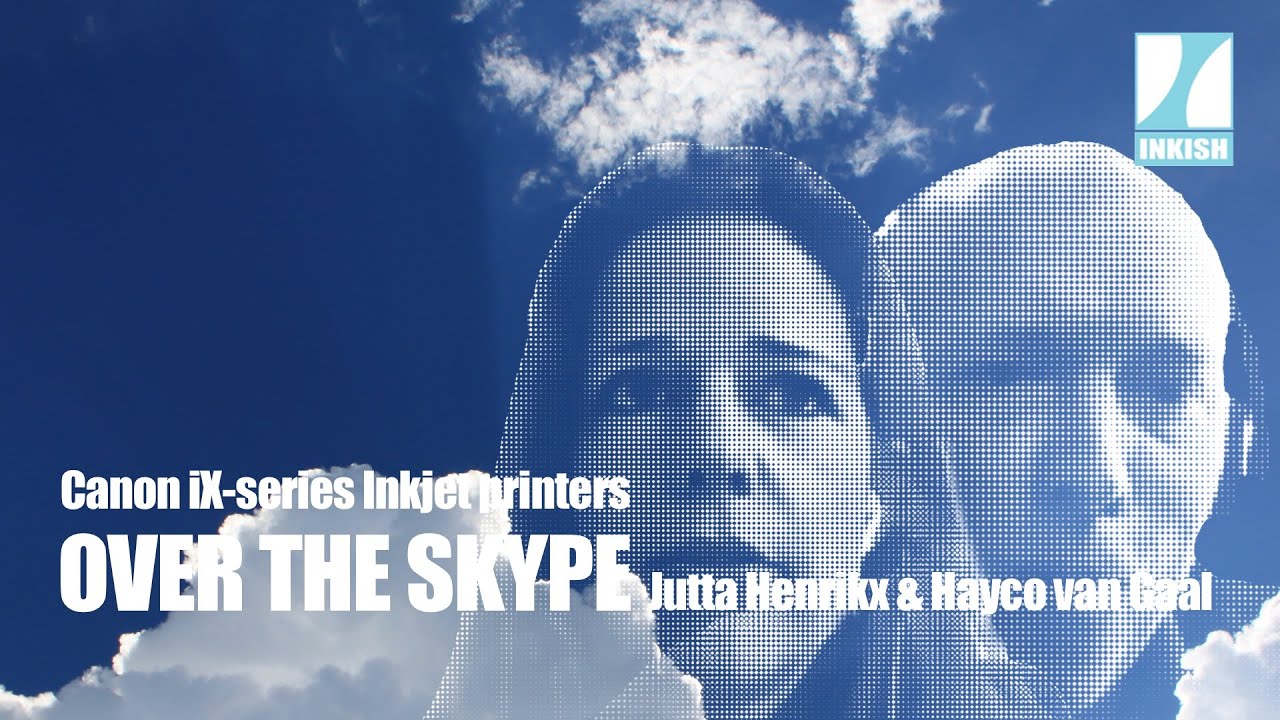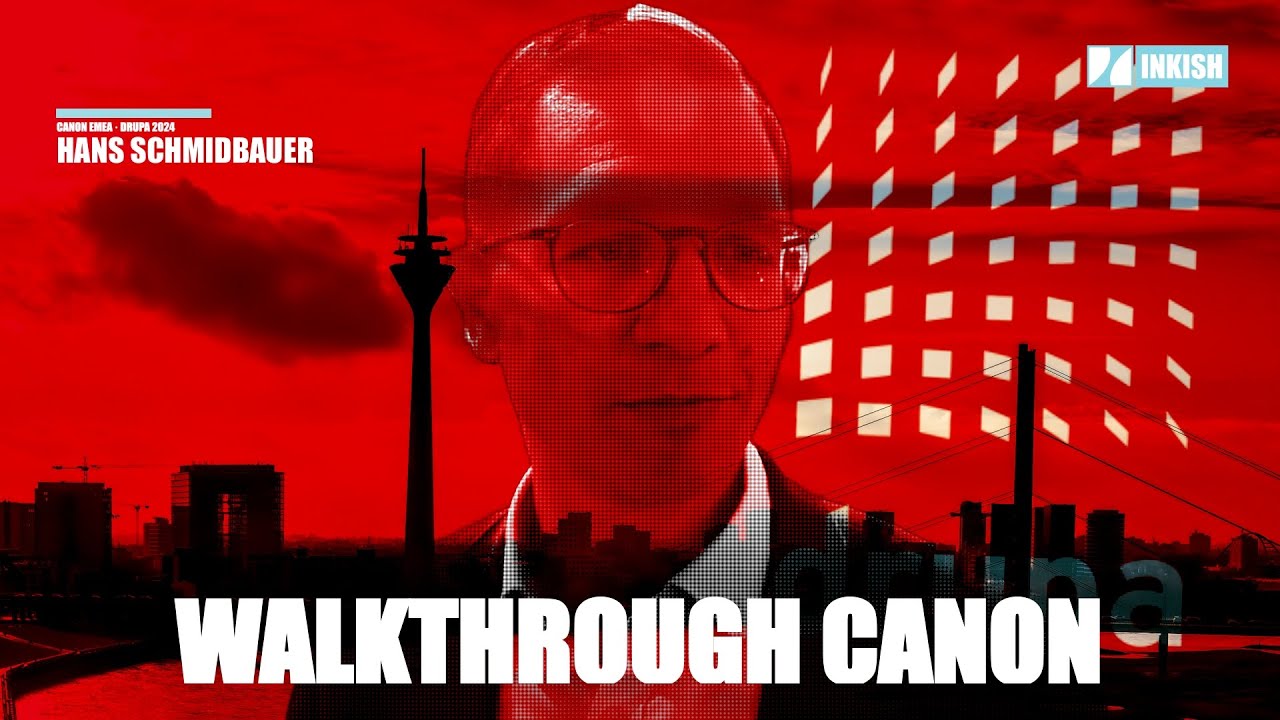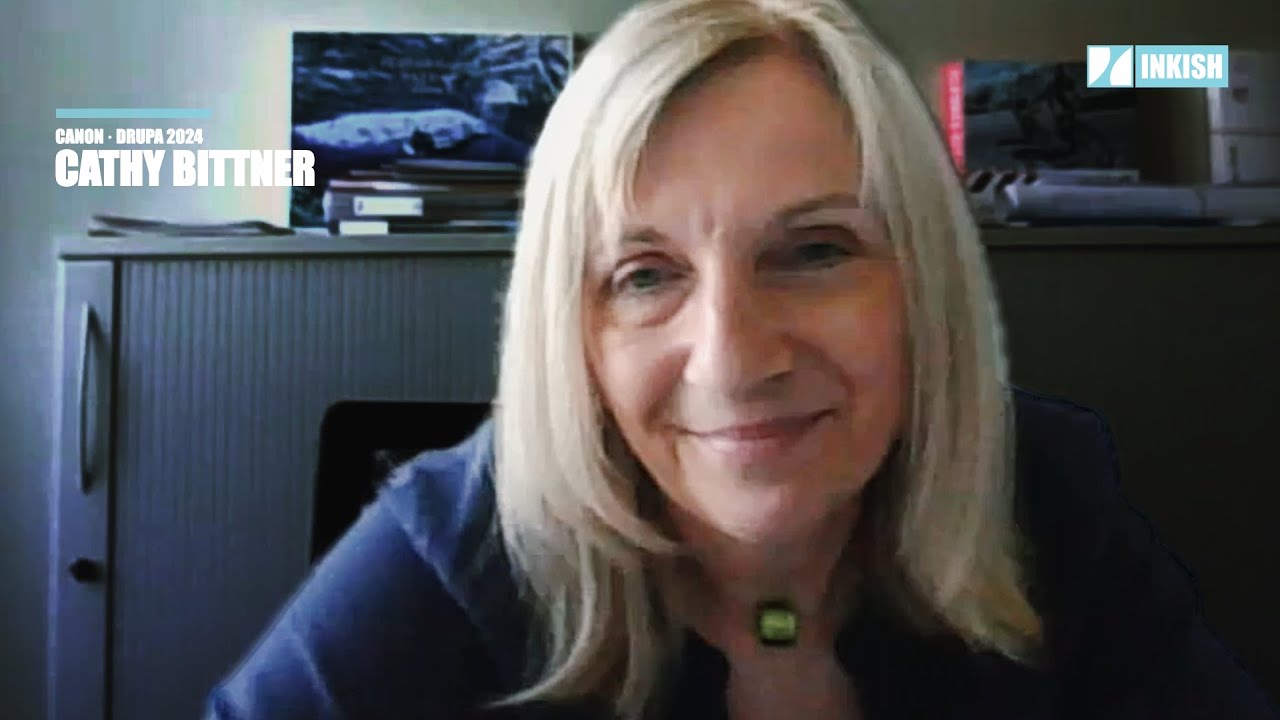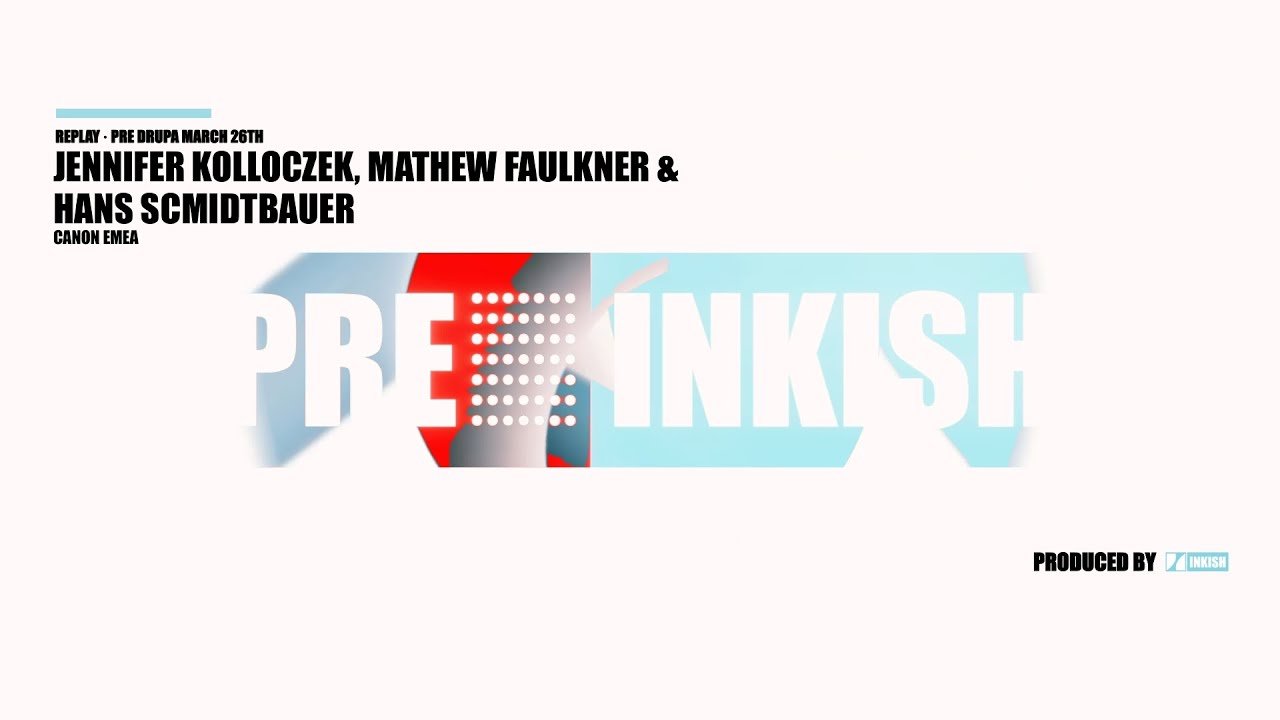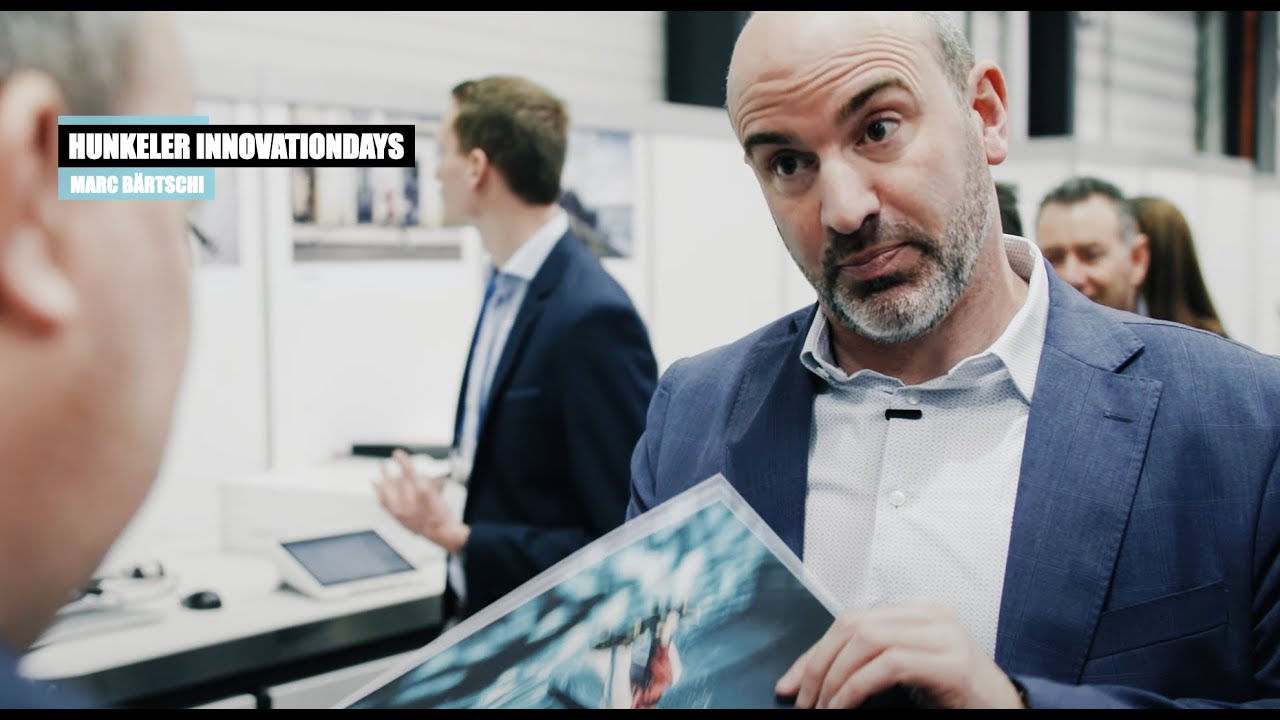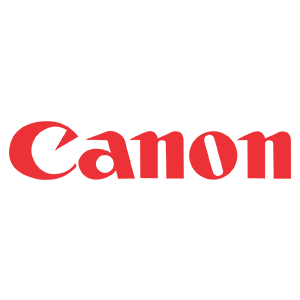Jutta Hendrikx & Hayco van Gaal · Over The Skype · The New Canon iX-Series printers
In this conversation with Jutta Hendrikx and Hayco van Gaal from Canon Europe, we get a chance to talk about the new iX-series sheetfed inkjet printers from the global print-giant. We also get the very first view of the machine in action, filmed by Hayco van Gaal from their experience centre – so that’s all very cool.
As with all our ‘Over the Skype’ interviews, quality is limited to bandwidth, web-cams, and ability to literally LIVE mix the conversations. However, it works, and with Over the Skype, we will bring you more than 20 exciting people, and angles on the industry as it is right now.
Enjoy!
This is Morten from INKISH TV. So today we have yet another episode here on all the Skype, you can say. I just invented this title for this very unusual way of doing the INKISH films, but due to the coronavirus, this is how it is right now. And today we do doing something completely new, because we are, first of all, we have two guests. One is Jutta Hendrikx, and secondly we have Hayco Van Gaal from Canon Europe. And so Jutta, maybe you should just start telling a little bit who you are and what you do.
Ah, thank you, Morten. Yes. My name is Jutta Hendrikx. I’m the European Product Manager for sheet-fed inkjet presses at Canon Europe, and I’m very happy to talk to you today.
Every time I talk to people like yourself, Jutta, is I am sometimes wondering if your business cards are extremely long with these long titles. Is that the case?
I don’t know. I can only say that I’m … No, it’s not extremely long.
I was just joking a little bit. It’s just to relaxing a little bit. Okay. So don’t worry, that’s not too serious with everything. Right. And you work with the sheet-fed and you work on a European level, so you’re working with all your local partners in order to help them and support them in the sales of the sheet-fed inkjet presses. Is that what you do?
Exactly.
Okay. That sounds great. Our second guest, that is Hayco Van Gaal, and you are in your experience centers in … Where is that located?
Hi, Morten. This is Hayco. The experience center is located here in Venlo in the South of the Netherlands. And this is actually also the center where our research and development premises are based, our machines and logistics are based. And this is actually also the center where all the magic around sheet-fed inkjet technology happens.
Oh, really? That sounds great. And what is your position and what do you do at Canon?
I will not mention my business card title after your joke. No, as you know, Canon is, from a global perspective, they work in regions. Americas is one of the regions, Europe, Middle East, and Africa. EMEA is one of the regions. Within this region of EMEA, we have several business pockets going from cameras to medical systems to commercial printing. I’m working in this commercial printing area, and if you look at this area then you could say that we have two kind of technologies that we are using in this commercial printing area. The web fed systems, which are engineered and produced also in the South of Germany in [inaudible 00:03:00], and the sheet-fed inkjet systems, which are engineered and produced here in Venlo. And my responsibility with the whole team is to make this sheet-fed inkjet business a big success in the European marketplace.
But it always starts with a good machine. So I think that we are in the right spot right now.
Yeah, yeah. And to be honest, I have a kind of a worldwide premiere for you, because you don’t see it in detail now, but on the background here, in my background, we are actually now building up the machine VarioPrint IX3200 with serial number one.
We have to see it afterwards, Hayco. You have to take some footage so we can show our audience that you are actually telling the truth about serial number one. Don’t you think so?
Yeah, exactly, but I just wanted to give you the honor that you are one of the first people in the world who can actually see this machine via Skype.
That’s super great. Thank you very much for that opportunity. Before we talk about the machines themself, because it’s for the people that don’t know that you announced this last week as we’re supposed to be Drupa news, but since Drupa has been postponed, you announced this last week to the world. So we’re going to talk about that in a moment.
Jutta, from your perspective, what kind of markets do you believe these presses are made for, suitable for?
The new VarioPrint IX series is suitable for the general commercial printing market, as it totally fits into the needs of the general commercial printers. While they are using, on the one hand, they are asking for very high image quality and high digital flexibility, they also search for high productivity and also cost efficiency. And that’s what we believe is, yeah, actually the VarioPrint iX series in one device.
Fantastic. And before I let you go for on this question, when I talk about the market, I was wondering is it large companies or small companies or what kind of printing companies do you believe is this machine target for?
I think I would rather refer to the volume and to the applications of our target customers. So with the VarioPrint iX series, we targeted volumes from one million up to 10 million for prints per month and applications from catalogs, magazines, postcards, direct mailers. And so for me it wouldn’t matter whether it’s a very large entity or whether it’s a smaller entity, as long as the application and the volume fit here.
So just to put that 100% correct, I’m sorry that I’m joking a little bit. That’s the stupid Danish humor. I was more like trying to figure out where in the market it fits. And I guess you’re completely right that you had mentioned the applications and the volumes there and that, but I guess that with the price tag of a machine, I don’t know the prices, but it’s big. So I expect it to be something that you should have deep pockets to get into. But you’re saying is that you need basically if you have the right applications, if you have the right market, it’s not so depending on the size of your company. It’s more like how you actually can make your revenue based on this machine.
Exactly. So it’s always that the business case needs to fit and the business case is for sure based on the volume and the applications, which then also is a combination of the media you use, et cetera.
Sounds great. Now we’re going a little bit into the machine before. Maybe we’ll mix a little bit around with this, but when we look at the machine, maybe you can answer that, Hayco, because Jutta is mentioning the types of application. But one of the things that I believe that Canon has a high repetition for with the I300 and I200 is also your capabilities of printing on uncoated stock, and that has led to a quite big interest from the book publishers as well.
Yeah. I think that’s a very important thing. If we talk about technology and the capabilities of the technology, when we started 10 or 15 years ago with high-speed inkjet printing, it was either you had to buy very expensive paper to get a certain acceptable quality or you had to deal with the quality which was not on the level that was maybe requested by the market. And the role of paper in that process is a very important one, Morten, that’s for sure.
The core focus in the development of the VarioPrint i300 and now also for the VarioPrint iX series is that we actually don’t want to compromise in that area. It would be strange if we can as a proposition say to customers, “Well, we have very attractive running costs for you based on our inkjet proposition, but you have to buy very expensive paper in order to get a high quality.” That’s absolutely not what we want. So basically both for uncoated paper but also for the traditional offset coated papers, the philosophy behind this machine is that our customers can use the papers that they are used to in their traditional way of working.
Yeah. And to maybe underscore that kind of thing is that you don’t even need pre-treated paper, like for example, and all that. The new way to go, machines also have some kind of treating things inside the machines, but your machine has also, since the i200 and 300 came out, you have this color grip technology that you have built into the machine. That is exactly what you’re talking about. That enables the printers to use any kind of substrate on the machine, right?
Yep, that’s correct.
Can you explain a little bit what the color grip does or what it is?
Well, what it actually does, to make it simple, it’s a kind of salty liquid, and what it does for the uncoated papers, it makes sure that every drop of ink that you put on the paper, cyan, magenta, yellow, or black, will be put on top of a drop of color grip, and that makes sure that the pigments of the ink will not disappear into the structure of the paper, into the fiber of the paper, but it will stay on [inaudible 00:09:35] the paper so that also your color and your color density is on the right level. That’s more for the uncoated papers.
For the offset coated papers, the biggest challenge for water-based inkjet is always to make sure that your drop of ink and your full color image stays on the paper …
That would be nice.
… and the drop doesn’t disappear or become a bit blurry. And for offset coated papers, the color grip liquid makes sure that the drop sticks on the place where it should be and that from that perspective we have a very high image quality and also, of course, a very high color gamut.
And this color grip technology, is that something that is unique to the i-series machines or is that something that you’re using in some of your other machines as well?
That’s a very good point, Morten, because if we look at our high-speed inkjet portfolio at the moment, then we have on the one hand the roll-fed machines, the web-fed machines, and on the other hand the sheet fed, the VarioPrint i-series and iX series, and especially with the iX series and also with our web-fed ProStream technology, we really want to accelerate now into this general commercial printing market, as Jutta just stated. And also on our ProStream technology, so on the high speed continuous feed to inkjet machine, we also use this color grip technology in order to be able to print on these offset coated papers.
Fantastic. And talking about general commercial printers, as you just mentioned, Hayco, maybe Jutta can elaborate a little bit on this, because one of the things that I guess a lot of media paid attention to it is the fact that the machine with the specifications and also the emphasis of high color gamut and quality and uncoated paper seems like a competitor to some of the Indigo machines. Is that something that is intentionally from Canon’s side or is it just what happens?
When you have a look at the Epic capabilities, you’re absolutely right. We actually enter in the market of digital cut sheet as we offer a device which is, yeah, having a very high image quality rivaling also other technologies. And I wouldn’t say any specific competitor is now that we are going to attack anyone, but it is rather very good promise for the general commercial printing market with regard to either offset or digital toner.
The reason why I mentioned the Indigo machines is that because the high end market seems to have adapted the Indigo as a standard. When I was in Boca, Florida last year filming from your headquarter in Canon Solutions America, I was quite impressed by the quality, because with the high speed roll-based inkjet printers, it used to be more like transactional print. And my question is more like the objective of doing this high quality. Is it because you basically believe that it’s now is the time for inkjet devices to go into a wider range of applications in traditional commercial or printing companies, Jutta?
Exactly. And these are exactly the target applications we are offering. So for us, inkjet is now really much more than it used to be. So really when you have a look, and that is really unfortunate that we do not see each other face-to-face, and I can really show you the print ads at this moment. It’s really great what we can now achieve with inkjet sheet fed. This is a quality which really [inaudible 00:13:31] away and it’s really great.
Super. And Hayco, when Canon is addressing the commercial market, as you just spoke about, both of you, why a B3 format and not B2 format? I think a lot of your competitors are looking into those sheet sizes right now. Do you have any ideas about that?
Yeah. For this technology platform, we have specifically chosen to stay within in the B3 size. If we look specifically at the market that we are targeting right now, this general commercial printing market, and I think we can also include the online printers in this target market, Morten, because that’s an important one for us.
Typically what we see that some of the customers in this market space have indeed in the last years migrated to the B2 size. For some circumstances, especially if we go into the area of packaging applications, this move into B2 is really driven by the end product here, by the end application that these customers want to produce. However, in many cases, in the general commercial printing market and also with the online printers, it is not based on the end product that they want to produce. It is purely based on a kind of operational excellence in order to get more output for a certain total cost of ownership out of your value stream. And that is exactly what it is about. How many end products do I get out of my production line in a very high quality for a very competitive price.
That’s what it’s about, and this is why we say, “Well, B3 is the production size which can accommodate, I would say, 90% of all the commercial printing products that are being produced by these companies. And therefore it is our goal to make sure that we can produce as fast as possible with a very high throughput, very high quality for a very competitive price.” And therefore we don’t need B2 at the moment.
I understand that perspective of that decision that you’ve come to, but the reason why I’m asking is also because you know as well as I do that the quality and the speed and even the acquisition cost of an inkjet machine today is not only competing with toner based and other inkjet devices in the market. It’s also now quite attractive as replacing some of the offset machines in the market.
And if you look at commercial print, they may have binding equipment that fits the B2 format. So that was why I was curious, because that must be something that you have considered anyway, I guess.
Yeah. Yeah, that’s a good point. So if we look at it from a purely offset point of view, then indeed many customers, I would say, in the last five years have even migrated to B1. So also there the bigger size has become more the reality. So a lot of the traditional finishing equipment in these companies is definitely based on a B1 way of working.
What we see, however, is that in many hybrid companies, so the companies where they have either offset and digital, still the digital way of working is a separate way of working if you compare it with their offset way of working. So also, if you talk about finishing, the finishing devices used in the digital departments are not per definition the same devices as they use in their traditional operations.
And if we then go one step further, because if we talk about automation and if we talk about getting the right products as soon as possible out of your production equipment, then inline finishing can also be a very interesting aspect. As to what we see a lot at our customers even already, also, with the current i300 and i200 is that they use inline booklet makers, inline cutting devices in order to get a complete finished end product out of their machine without any manual intervention. [crosstalk 00:17:55] strongly believe in.
Yeah. And I also think that at the Hunkeler Innovationdays in the last year, Hunkeler has always been in the roll-based finishing, and they support the i300 with the first sheet-based finishing product for Canon. So I think you have a good point that maybe one of the things that I personally also find about the sheet-fed based printers rather than the roll-based is that a lot of the commercial printers, they change substrates quite often and needs to be very flexible in getting that equipment and those applications aligned.
So Jutta, is that the reason why you have two-leg strategy where you have both role-based and sheet-based? Or can you elaborate on that?
Yes, exactly. You absolutely make the point, because when you think about the media flexibility you are gaining with sheet-fed, this is exactly the reason why we have developed four or five years ago the VarioPrint i-series, because we wanted to bring the productivity of inkjet with the flexibility of different kind of media together. And with now more than 250 installations worldwide, we really, yeah, have received the feedback that this is really the right way to go forward, and that’s the reason why we really want to accelerate even more and have invented and invested in the development of the iX series.
One of the things I wrote in my article on INKISH News about the introduction of iX series was also that one thing is the equipment and one is the market and the changes in the market. Another thing is also how an organization is able to serve your customers, because with all the investments that operationally, the support needs to be good. I think that Canon has an extremely good repetition in the market. How do you keep up with that? Because with more and more machines, I guess you need a larger and larger organization. Or is it also possible to do some of the services on a remote basis, Hayco?
I think that if we look at the success indeed of the last years, that has enabled us and also our customers to get a lot of experience in the area of inkjet. We talked, for example, about our color stream platform. I think we have right now more than 1,400 machines installed worldwide.
Wow. Wow, that’s a lot.
250 VarioPrint i300s. And of course that’s nice for us that we sell that many machines, but that’s not what it’s about. It’s about getting a critical mass into the market, getting a number of machines in each country, also in Europe, enabling us to build an organization around these machines. So it’s nice that we have very good salespeople, but it’s much more important that we have good engineers, good service people, and also good consultants to make sure that every installation at a customer is a success, because selling is one, but making money with it from a customer’s perspective for the next seven, eight years, that’s much more important.
And having all these machines in field enables us to have a complete organization around our inkjet machines. I think there’s no other player in the market who has such a spread in the market and also such a high knowledge level in terms of the engineers, and that enables us, indeed, also to go now for a next step, broadening our market, also, with these general commercial printers based on the organization that we have in place and also based on the knowledge that we have in place on inkjet technology.
That makes sense. I was just wondering with the 250, 300 in the market, is there space for selling more or you also expecting to replace some of the existing machines in the market? I mean, of course there’s thousands of printing companies all over Europe, but I guess that since the i300 was introduced to the market that you have probably worked as much as you could to get these machines into the market. But you still believe there is a need for this type of equipment?
I think yes. If you look at the 250 i300s that have been installed in the last four years, I think I can say, at least for the European market, 75% of these installations is in the area of transactional printing, direct mail printing, book printing, or manual printing. So only 25% of these installations is in the, let’s say, more general commercial marketplace.
And if we then look at the market size and the business and also the volumes in the market, not only from a digital perspective, but also from an offset perspective, it’s much more in the general commercial area. So if we then combine that with the capabilities of the new iX platform, I strongly believe in the fact that there’s a huge market waiting for us in the coming months and years.
I mean, if you look at the market, it seems that you have a very great machine. Nobody can see the print yet and we cannot go and see it because we cannot travel right now, but at some point we will see some excellent … One thing that we forgot to talk about, Hayco, was also … Hayco, sorry … was also that you got a new ink on it. Right? So that is what is bringing a wide gamut to the machine, isn’t it?
Yeah. We have now introduced the fourth generation of inks for the iX platform and more than a hundred people here in Venlo are only working in this area, for example. And it’s about the combination of ink and the print head and the paper and, of course, the image processing technology that you are using. It is not that the ink has a bigger color gamut, this fourth generation ink. The crucial thing in inkjet printing is always how can I get enough ink on the paper, because-
So it’s a [crosstalk 00:24:21] or more like that or …
Yeah. If you look theoretically, the theoretical color gamut of inkjet as a technology is extreme. But the question is with a very high speed, how can I get as much ink on the paper as possible in order to reach the full color gamuts that I definitely want to reach? And now we have made now a big step in developing a new ink, but it’s not only that ink. It’s that new ink in combination with a complete new drying technology that we have introduced now in this iX platform.
Yeah. This is the [inaudible 00:24:58] that you’re referring to, right?
Yeah, it’s an addition to the existing [inaudible 00:25:03] set that we already have in the current i300, and we have extended that with what we call a new post fixation unit. And I dare to say that this is really the magic in this new platform. So after the regular drying that we had already in place, we have now introduced a second drying step, and that drying step enables us to go into these higher [inaudible 00:25:28] offset coated papers with a very high quality, and as you said, a very high color gamut, also.
When I saw that in your brochure on your website, it said that it was like water-based with polymers. Is that basically the second heating unit on the dryer? Is that basically melting polymer so you get that kind of structure that you need in order to get enough ink on the paper, or how does it work?
Yeah, I think you pointed it out very right. So in the first drying step we make sure that all the water [crosstalk 00:26:06].
Excess water is recognized. Yeah.
And in the second step, we will make sure indeed that we get in the end a very robust layer with a very smooth surface, also, that enables our customers also to do immediately finishing after printing, because that’s also an important aspect in the printing process, of course.
Of course. Jutta, one of the things that I also noticed in your marketing material was that you emphasized that it comes out flat off the printer. Is that because that is something that could be an issue with inkjet? Because, I mean, I guess that when you put water on paper you can have not flat surface. Is that part of the value proposition that a printer should take into considerations?
Absolutely. It is a really crucial that you have a flat print. Think about post-processing when you post-process books or magazines and there are waviness, then you really get issues. And actually, the technology Hayco was just referring to with a post-fixation unit helps us to really have a very flat print, and the reason is a humidity shot. So in the post-fixation unit we use humidity, and although we are using for a very short moment a lot of heat in order to get this polymer melted, this humidity helps that there is no moisture getting out of the paper. So therefore we have a very flat print, also, after the printing process.
And does that mean that the sheets are directly able to be finished when they come out of the machine?
Yes, exactly.
So great capacity on the input trace, fast throughput, paper that doesn’t need to be treated, a new drying system that makes sure that everything is delivered in the highest quality flat. And I think we have argued, not argued, but discussed the paper size. It seems that you have a machine that seems to be a winner, right? I think it will be interesting to see how the market will take. Have you got any feedback from the market so far on this machine? Who wants to talk?
Yeah, I think before the corona situation that we are unfortunately in right now, Morten, we had the opportunity to invite 35 customers here in Venlo. They, of course, signed a non-disclosure agreement and they had a look behind the curtain. So we showed them the engineering prototype of the VarioPrint iX, and that also enabled us to get a lot of feedback. We showed them the technology. We showed them the concept, but we also showed them output, the output quality based on some applications that we had defined. So we made some cards, some magazines, some brochures on uncoated papers, on coated papers. And we also took the opportunity to do the same exercise with toner technology, liquid toner technology, and also LED UV offset technology.
So we enabled our visitors to have a kind of quality game and to compare our new technology with the technologies that are already available in the market. And of course, I work for Canon, so I’m not completely neutral, but the feedback from all 35 customers, and many of them were current liquid toner users, feedback was very positive.
Great. The last thing I want to talk to you about before we end this nice session is entering into the offset market. I think that some of the offset printers has … Some of them have a lot of understanding and knowledge about [inaudible 00:30:00] print today as well. But I think that when you go to inkjet, how is the operational cost, because I think that is a concern. If you move from one technology to another, will that dramatically change the cost structure of your products and services? And is it possible at all to predict? Because I guess that if you pay, not click prices, but consuming ink prices, I take that you have to calculate the surface coverage to get accurate prices. How do you see that?
First of all, I think it’s not our primary target to attack or to replace offset volumes. Our primary target is to have a total cost of ownership and a business model in place in order to be competitive with the current way of working. And as Jetta already said, it’s about toner technology. It’s about liquid toner technology. There we have now a very appealing business model in place to make sure that for our customers it’s more interesting to work with our sheet-fed inkjet technology.
If you have that in place, then the next step will, of course, be that if you then compare your total cost of ownership with your offset operations, then you will automatically see that the break even points there where we always talk about, these break even points are going to shift. They are going to shift more into the direction of sheet-fed inkjet. So our expectation is that as a result of our new economics, of our new business model, in the second step, there will also be offset volumes coming to our technology.
But that is more like a result of understanding the value proposition of the inkjet machine. Rather than you try to replace a market, when you get it into the commercial printers and they can see the advantages and the total cost of ownership, then you believe that the volume will change by that measures, basically.
Yes, exactly. Exactly.
That’s awesome. Well, anything you want to add to the conversation? I think it was great, but you have the last words if you need anything. Jutta, do you think you want to add anything to this film?
Yeah. I think in general, it was great talking to you.
Great talking to you, too.
Yeah. I really would love to see you, also, face-to-face and meet you once.
I hope so, too.
And that we can also show you what we have talked about today and that we meet you then at the CEC or maybe at the next fair.
I’m sure we will see each other at some point, anyway. And Hayco?
Yeah. Thank you for asking, Morten. And you know I’m a big fan of your articles on the social media.
Thank you.
Of course, I also read your article about the iX. I really liked the angle that you took to see it from a different perspective, from a customer perspective, from a management perspective. I was really triggered by your remark about the uptime, the 90% uptime that we emphasize in our external communication. And for us, that’s a very important one, because if we talk about this uptime and we talk about the target market that we are in, the general commercial printers and the online printers, that they talk about overall equipment efficiency. And in the end, that’s about uptime. It’s about throughput and it’s about the quality, so the quality ratio of your production.
I think there, inkjet technology, if you compare inkjet technology there with the technologies that have been used in the last 10, 15 years, has a very high advantage. If we talk about if it’s 90% or 87 or 93, it doesn’t matter. It’s at least 15 to 20% points higher than the traditional technologies that are being used in the last years. And there I think we have a big advantage, and that was my trigger in the article that you wrote. That’s the only thing I wanted to touch upon yet.
That’s totally okay.
No final remarks from my side.
Okay.
Thank you for your question.
But that led to one question that I want to talk to you about, because even though I said that it was the last one, it’s just because I tell you the reason why I’m sometimes interested in talking about uptime and maybe even more utilization degree ratio on these machines is basically that I know from some of the large offset vendors that sometimes you have printing companies where the utilization is only 25%. so when you have very fast, very effective printers like the Canon iX series, then it will need a lot of work in order to be utilized 100%. so the uptime is, of course, one thing, but the utilization is a second thing. So that is one of the reasons why I’m always very interested in those perspectives. So just so you understand why I was asking this, right?
Yeah, okay.
Yeah.
Yeah, thank you.
And I guess that the only thing that Canon can’t guarantee when you invest in an iX series is how many customers you get, right?
No. No, you don’t get a guarantee on that
No. So that’s the hard work you have to do on your own. Right?
Yeah, yeah.
Well, Jutta and Hayco, it was a pleasure to meet you. I will stop the recording now and then we’ll just finish talking to you before we hang up here. So thank you very much, guys.






























































